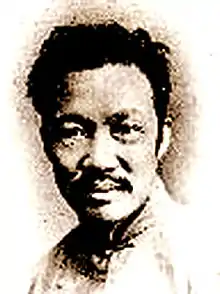Xu Xusheng
Xu Xusheng, also known by his courtesy name Xu Bingchang,[1][2] (1888 – January 4, 1976) was a Chinese archaeologist, historian, and explorer born in Tanghe, Henan Province. Best known for his discovery of the Erlitou culture in 1959, he was one of China's most important and respected archaeologists and historians of the twentieth century, providing a model of archaeological methodology for future Chinese archaeologists. He also was president of Beijing Normal University.
| Xu Xusheng | |||||||||||
|---|---|---|---|---|---|---|---|---|---|---|---|
 Xu Xusheng photographed at Beijing University in 1920 | |||||||||||
| Chinese | 徐旭生 | ||||||||||
| |||||||||||
| Alternative Chinese name | |||||||||||
| Chinese | 徐炳昶 | ||||||||||
| |||||||||||
Biography
In 1921, Xu was appointed professor in the department of philosophy, Peking University, teaching History of Western Philosophy. In 1926, he served as provost of Peking University, and in the following year he led an expedition to northwest China to conduct archaeological investigations. In 1929, Xu served as dean of National Peking University Women's Teachers College. He also was president of Beijing Normal University from February 1931 to May 1932.[3] He traveled to Xi'an in 1933,[4] where he established the Shaanxi Archaeological Society. From 1934 to 1937 he investigated the Early Neolithic culture in Shaanxi Province, discovered by his team of archaeologists who carried out excavations at the Doujitai site in the middle Yellow River Valley, where his approach was said to have served as a model for archaeological methodology.[5][6] He became director of the Institute for Historical Studies in 1936.[2]
Xu was instrumental in conducting the first modern study of China's early "myths" based on the reports of antiquaries findings by archaeologists.[7] He also worked on the Historical Gazetteer of Beiping.[2]
He was elected to the Chinese National Assembly in 1947. Xu became a research fellow of the Institute of Archaeology of the Chinese Academy of Sciences, and surveyed Gaocheng in 1959.[8] The Erlitou culture was discovered by him that year.[6] He joined the Chinese Communist Party in 1957, and was elected to the Third National People's Congress in 1964. Persecuted during the Cultural Revolution, Xu died during January 1976.
Research
As a historian, Xu authored the 1943 book, Zhongguo gushi de chuanshuo shidai ("The legendary times in early Chinese history"), where he comments that the name of Five Emperors was not mentioned until the Warring States era and cannot be found in earlier works such as the Zuo Zhuan, Guoyu, Lunyu, Mozi or Mencius.[9] This was the first book to provide detailed facts concerning ancient Chinese history and archaeological finds and present a comprehensive history of China's prehistoric period.[9][10]
References
- "Xu, Xusheng, 1888-1976". National Library of Australia.
- Murray, Tim (1999). Encyclopedia of archaeology: The great archaeologists. ABC-CLIO. p. 591. ISBN 978-1-57607-199-1.
- "Former Presidents". Beijing Normal University. Archived from the original on May 18, 2012. Retrieved 25 October 2012.
- Loewe, Michael; Shaughnessy, Edward L. (13 March 1999). The Cambridge History of Ancient China: From the Origins of Civilization to 221 BC. Cambridge University Press. p. 1103. ISBN 978-0-521-47030-8. Retrieved 25 October 2012.
- "Searching for the Earliest Neolithic Cultures in China -- from the Perspective of Ceramics". Bureau of International Cooperation. Retrieved 25 October 2012.
- Liu, Li; Chen, Xingcan (31 May 2012). The Archaeology of China: From the Late Paleolithic to the Early Bronze Age. Cambridge University Press. pp. 7, 259–. ISBN 978-0-521-64310-8. Retrieved 25 October 2012.
- Wilkinson, Endymion (2000). Chinese History: A Manual. Harvard University Asia Center. p. 568. ISBN 9780674002494.
- Bulletin. Indo-Pacific Prehistory Association. 2004. p. 89.
- Chang, Kwang-chih; Xu, Pingfang (2005). The Formation of Chinese Civilization: An Archaeological Perspective. Yale University Press. p. 8. ISBN 9780300093827.
- The Formation of Chinese Civilization: An Archaeological Perspective. Yale University Press. 2005. ISBN 9780300093827.
External links
- Hudong Encyclopedia entry (in Chinese)